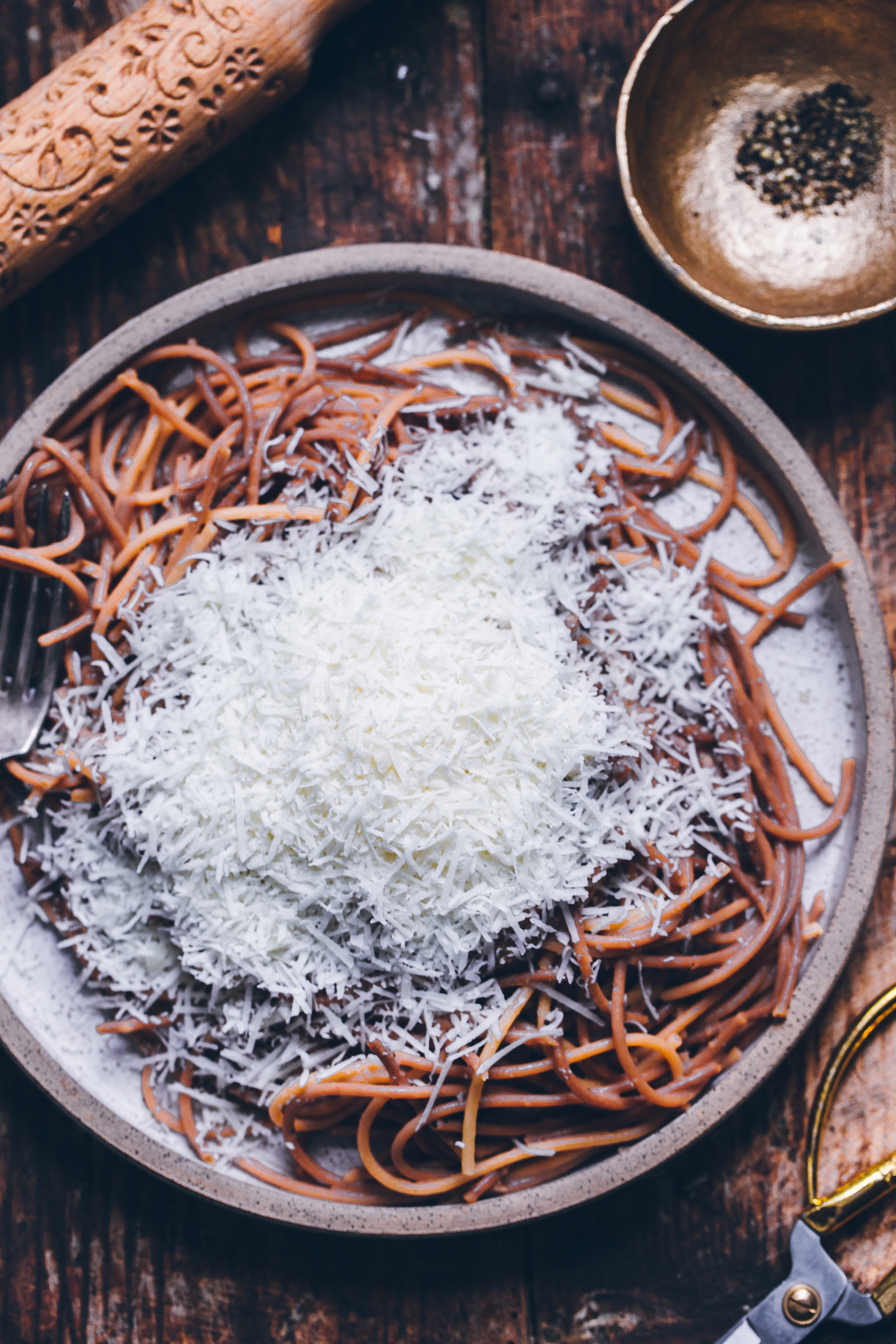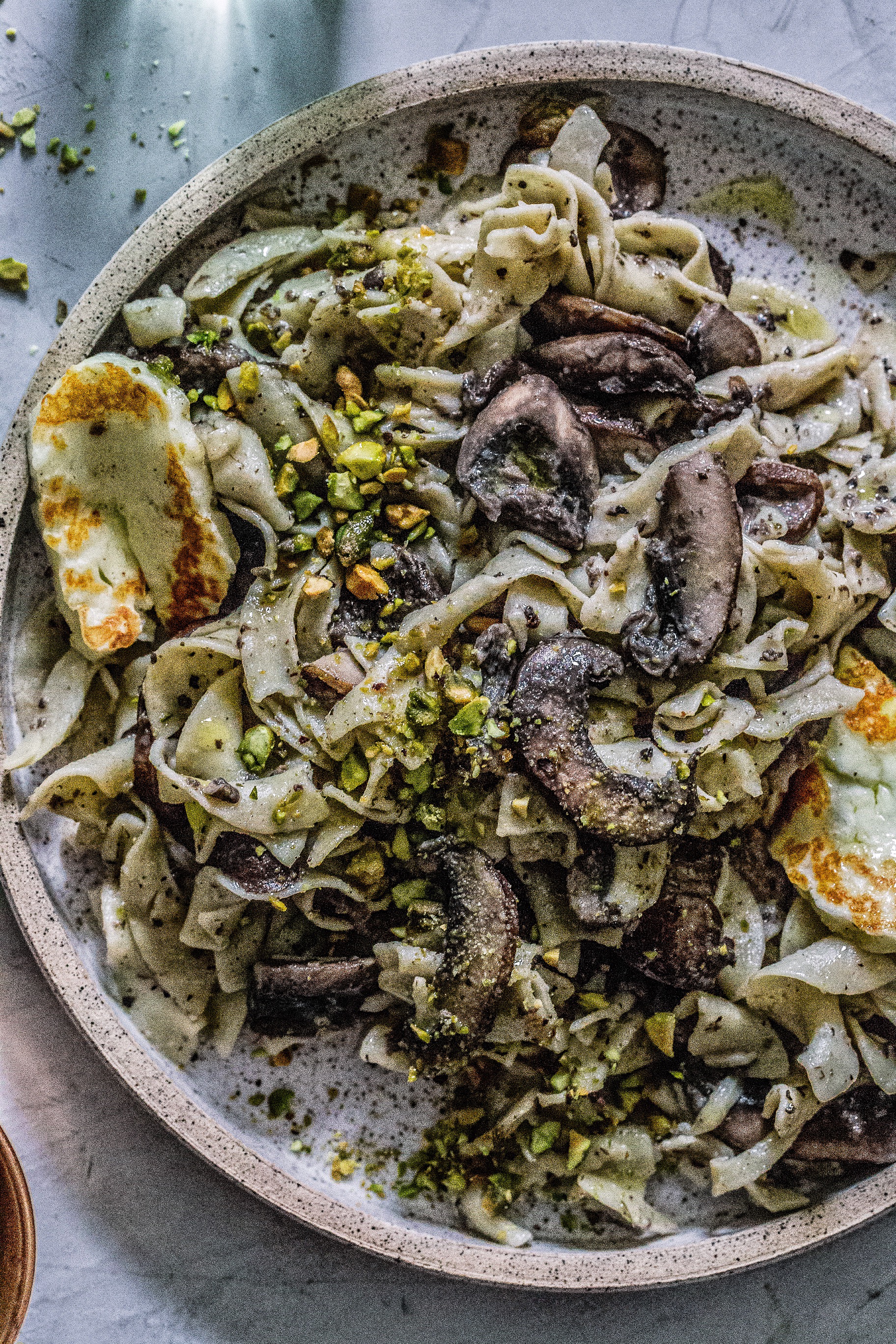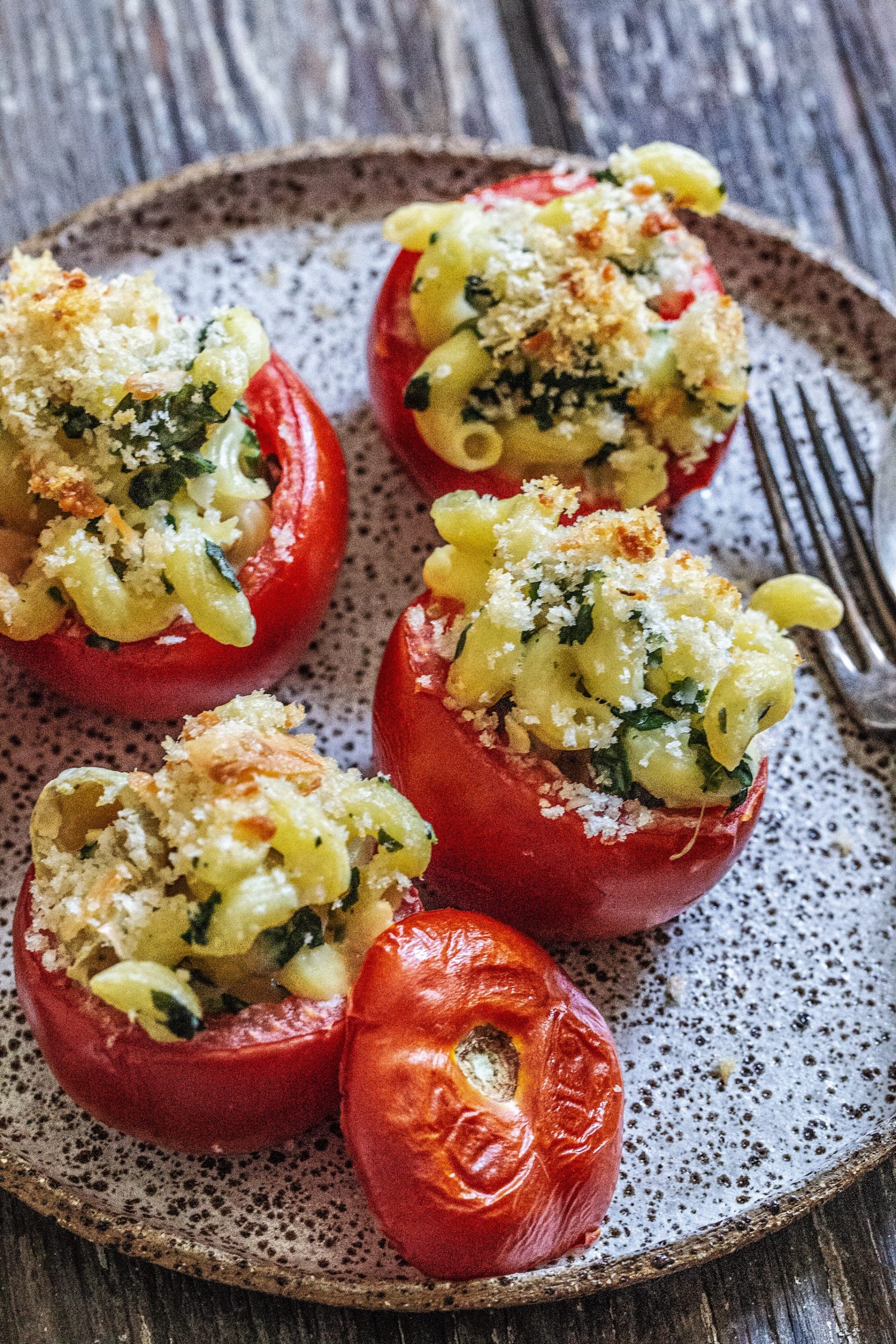We’re diving back into the annals of classic Italian cooking with this one (file this under things I get excited about). Yes, I’m sharing How to Make Authentic Roman Cacio e Pepe today, a dish that is a true wonder of the culinary world (not to be confused with my inauthentic-yet-delicious Cacio e Pepe Primavera). Conjuring incredible flavor and creaminess from three simple ingredients is a victory to be sure. We’re talking creamy, no clumps, spicy and peppery – all the goodness you’d expect from a perfect Cacio e Pepe.


What is Cacio e Pepe?
Translating from the Italian as “Cheese and Pepper” Cacio (cheese) e Pepe (pepper) is, to me, a perfect food. As such, when you can make something so incredible, so weirdly complex with just three utterly simple ingredients – then you’re absolutely winning. Italian food accomplishes this a lot and perhaps no single dish is more evidentiary of this truth than a classic, authentic Cacio e Pepe.
Here’s what authentic Cacio e Pepe has going on:
Pasta
Typically a long noodle such as spaghetti or bucatini.
Cheese (cacio)
Classically, pecorino, which is a sheep’s milk cheese “pecora” means sheep). Pecorino Romano, a hybrid cow’s milk + sheep’s milk cheese, is widely available and should not be difficult to locate in any American grocery store.

Black pepper
Typically this is freshly crushed with a mortar and pestle (Never ever should you use the pre-ground black pepper. It will taste like nothing in this recipe).



How to crush whole peppercorns, and why it matters
Okay, so seeing as how we’re dealing with a recipe that has only three core ingredients, it serves to really ensure that those three things are as great as they can be. This is a time when it’s worth springing for a quality pasta, selecting the best cheese you can find and yes – to actually take a few minutes to crush some whole black peppercorns by hand.
When you do this, you’re ensuring that the pepper flavor is STRONG and so very fresh. It will truly make every bit of difference in the whole wide world. Can you tell I’m passionate about this step? It’s true, I am. When you’re a big minimalist cook like we are here on MKL, sometimes the success of a recipe really does depend on working with quality ingredients. You can’t hide from your ingredient quality in a recipe like this one. It’s all laid bare right in front of you – you can see every ingredient from the start of the cooking all the way to the point where you take your first (amazing) bite.
I also ask you to do this in my favorite chicken wings recipe – and it totally makes the dish.

Best Authentic Cacio e Pepe Tips
Toast the pasta
This is my own special step that is NOT authentic but damn if it doesn’t add to the whole pizzaz of the finished dish. Plus? We’re not adding any more ingredients to the core three, the classic trio of pasta + cheese + pepper. So as I always say here on MKL, if we can play around with our small ingredient lists, and really maximize the ingredients as they are, then we don’t have to go adding a bunch of stuff just to make our dishes taste good.
Use freshly crushed whole peppercorns
Some extra steps are worth taking in the kitchen. Some are not. I take it upon myself to weed out the latter so as to make our cooking as efficient and effective as possible (so we can get to the eating of things). I do wax on about this elsewhere in the post, but trust me when I say that crushing your whole peppercorns by hand is of the UTMOST importance in an Authentic Roman Cacio e Pepe recipe. I mean, the recipe’s name has the word “pepper” in it … so, yeah.
Save the starchy pasta water
There are hardly any classic pasta recipes that don’t ask this of you. Saving our pasta water is so inherently clutch to the success of our recipes – it is literally what brings everything together. But this truth may never be so evident as it is in an authentic Roman cacio e pepe recipe. You see, it is actually the starch that prevents the cheese from clumping – the starch is what makes things cream the heck out and get all loose and correct for you. As such …
The brand you buy matters
Yes, we’re continuing on from our previous tip here, with the suggestion that you should pay attention to the pasta that you pay for. Say that three times fast! Anyway. We’re aiming for truly starchy noods here, so as to help with the smoothing of things. If you can, try to locate: bronze-die extruded pasta, as this will have the greatest starch content and will go to work for you hardest, when it comes to the sauce. If possible, I suggest purchasing Rao’s.
Bronze die-extruded pasta has a rougher, more golden surface. The rougher, less smooth surface helps sauce really cling to the noodles.
The amount of water you use matters
We’re “shallow-boiling” the pasta in this recipe which is to say – we’re not going to fill our pasta pot all the way to the tippy top. Reason being? (I actually almost always do this when cooking pasta) The less water you use, the starchier the water will be – it will be a greater concentration of starch-to-water. This starchiness, in keeping with everything we’ve been saying thus far, is key to creating that ultra-creamy cheese sauce in the end. So, just use enough water to fully submerge the noodles as they cook.
Salt the water, but this time – not like the sea
I’m always asking you to “salt your pasta water like the sea,” aren’t I? Yes, yes I am. This is how we get lots of great flavor and seasoning into our noodles before they ever even get sauced. But when we’re learning How to Make Authentic Roman Cacio e Pepe, we need to take care not to get crazy with the salting of things. Pecorino Romano basically makes up the whole sauce, and y’all – that cheese is SALTY. So, we need to watch how much salt we go adding into the pasta water. Just season it lightly, but not like, you know … the Great Salt Lake.
Boil the pasta for 2 minutes less than the “al dente” time given on the package
We will finish cooking the pasta in the skillet with the pepper and cheese paste, a technique that is called, “risottare” in Italian (sounds like risotto, yes?). This ensures that you won’t be digging into a big bowl of mushy, over-cooked pasta when all is said and done.
Pasta a la minute
Because authentic Roman Cacio e Pepe is basically just noodles covered in a blanket of cheese that has been thinned and starched into a cream sauce, things will go from loose and creamy to a dry, unappealing heap in a hurry. So, as much as I love recipes that you can make ahead, this is not one of them. The integrity of a great Cacio e Pepe will be compromised if it sits and cools. Gone will be the creaminess, lost will be the magic. Le sigh.

How to keep Cacio e Pepe from Clumping
Now, this really is explained in the tips above, but I don’t really come out and say it, in terms of clumping. This is my favorite tip/note/point of them all, actually, as I struggled to prevent clumps in my cacio e pepe for a long time until I really learned how to make it properly, before I learned the “why’s” of it all. But it’s also important to note that you almost can’t ever totally prevent ALL clumps. Honestly, I”ve never accomplished that feat but I’ve mitigated them to a large degree.
It is the starch content that really goes a long way in the prevention of clumps in a good cacio e pepe. The starchy pasta water, the starchy pasta itself – this all matters. We’ll shallow boil the noodles and use that uber starchy water to build a pepper sauce and the cheesy pecorino paste. It’s ALL ABOUT THAT STARCH. And the stirring.
All that said, I don’t think gooey, peppery bites of salty cheese is bad at all. Clumps are good! But only if you also managed to create a creamy sauce as well. That part is also important.
What You’ll need to make this Authentic Cacio e Pepe Recipe
Three ingredients. That’s it – that’s the whole assignment here, so far as your grocery shopping goes. So, since we’re only reaching for a few very simple things, let’s go ahead and make the absolute most of those three things that we can, okay? Okay.
INGREDIENTS
2/3 pound spaghetti or similar long noodle (this is the time to pick a quality brand)
Salt, as directed/needed
1 tablespoon of whole peppercorns
3 cups finely grated Pecorino Romano cheese



How to make Cacio e Pepe
This is a recipe that truly is all about the method. The ingredients are few and they are simple, unwavering. I don’t like to mess with the classic too much. I think it’s so brilliant and magical as it is – as it was initially intended to be. So, I don’t stray from tradition. People will add butter and oil to the mix sometimes, which of course is delicious, but I don’t think at all necessary. Here’s how to make cacio e pepe like a Roman would:
Authentic Cacio e Pepe DIRECTIONS
- Add just enough water to a large pot to fully submerge your pasta (we’re shallow boiling). Bring to a boil and season lightly with salt – not too much, as the pecorino is quite salty. Cook the pasta for one minute less than the “al dente” time given on the package directions (usually about 9 or 10 minutes). RESERVE 1.5 CUPS OF THE COOKING LIQUID.
- Place a large skillet over medium heat. Add 2 teaspoons of the ground/crushed peppercorns. Stirring, let the pepper dry-toast for one minute. It can burn so a minute is all you need.
- Add 1 ladle full of the reserved starchy water to the pepper and stir. Add the pasta, and stir/toss to help it finish cooking all the way through; takes a couple of minutes. Turn off the heat.
- Put the finely grated pecorino in a bowl and add a ladle of the starchy water, stirring to form a smooth, thin mixture. Add this cheesy mix to the pasta and Stir! Stir! Stir to meld it all together. Keep stirring until it’s super creamy. Taste and add a pinch of salt, if you think it needs it. There will likely be some cheesy clumps. I think this is just great. Hard to completely avoid, honestly.
- Serve right away, with a heap of extra grated cheese on top.

If you enjoyed learning how to make authentic Roman Cacio e Pepe, you might also want to check out these other How-To’s:
Baked French Fries (crispiest, best method!)
How to Make a Holiday Charcuterie Board
How to Make Your Own Tartar Sauce
How to Make the Best Cinnamon Toast

How to Make Authentic Roman Cacio e Pepe (okay fine, with a twist)
A true-blue classic, this Roman Cacio e Pepe recipe honors authenticity in its preparation and three-ingredient method. I give it my own spin by oven-toasting the noodles before boiling them, which adds a nutty depth of flavor to the finished dish. That said, it’s totally optional.
- Yield: Serves 4 as a side, 2 as a main 1x
Ingredients
- 2/3 pound spaghetti or similar long noodle (about 2/3 of the package usually; this is the time to pick a quality brand)
- Salt, as directed/needed
- 1 tablespoon of whole black peppercorns crushed (see note 1)
- 3 cups finely grated Pecorino Romano cheese
Instructions
- Preheat oven to 375 degree F. Put the spaghetti on a large baking sheet, spread out as much as possible. Oven-toast until deeply golden browned, but not burned; about 7 to 8 minutes (just keep an eye on it, you’ll smell it when it’s ready).
- Add just enough water to a large pot to fully submerge your pasta (we’re shallow boiling). Bring to a boil and season lightly with salt – not too much, as the pecorino is quite salty. Boil the toasted pasta for one minute less than the “al dente” time given on the package directions (usually about 9 or 10 minutes). RESERVE ABOUT 2 CUPS OF THE COOKING LIQUID.
- Place a large skillet over medium heat and add 2 teaspoons of the ground/crushed peppercorns. Stirring, let the pepper dry-toast for one minute. It can burn so a minute is all you need.
- Add 1 ladle full of the reserved starchy water to the pepper and stir. Add the pasta, and stir/toss to help it finish cooking all the way through; takes a couple of minutes. Turn off the heat.
- Put the finely grated pecorino in a bowl and add a ladle of the starchy water, stirring to form a smooth, thin mixture. Add this cheesy mix to the pasta and Stir! Stir! Stir to meld it all together, and keep stirring until it’s super creamy. Taste and add a pinch of salt, if you think it needs it. There will likely be some cheesy clumps – I think this is just great. Hard to completely avoid, honestly.
- Serve right away, with a heap of extra grated cheese on top.
Notes
For the Peppercorns: I crush my peppercorns in a mortar and pestle (if I can find mine), or just on a rimmed baking sheet, using a heavy implement such as the bottom of a heavy pint glass or rolling pin. There’s no “right” way to crush peppercorns, but there are several ways that I tend to lean on. The baking sheet + heavy glass is usually the winner.
Keywords: How to Make Authentic Roman Cacio e Pepe




